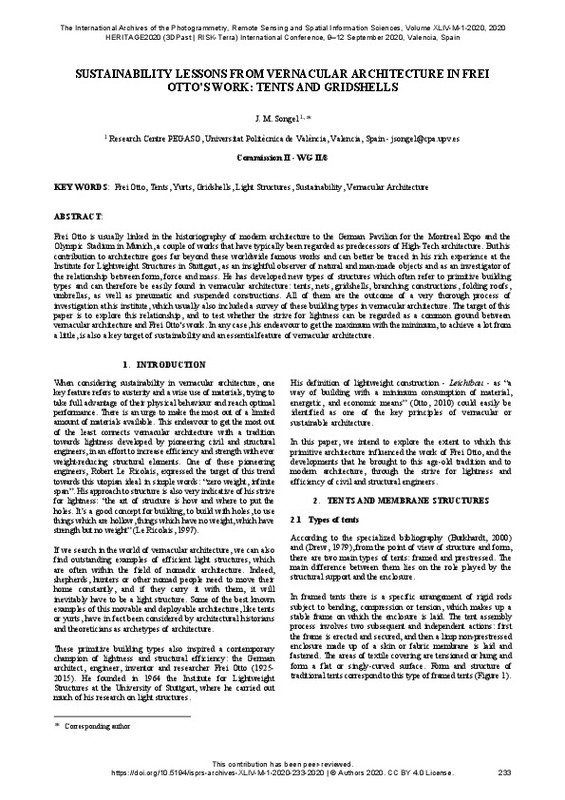JavaScript is disabled for your browser. Some features of this site may not work without it.
Buscar en RiuNet
Listar
Mi cuenta
Estadísticas
Ayuda RiuNet
Admin. UPV
Sustainability lessons from vernacular architecture in Frei Otto's work: tents and gridshells
Mostrar el registro sencillo del ítem
Ficheros en el ítem
| dc.contributor.author | Songel Gonzalez, Juan María
|
es_ES |
| dc.date.accessioned | 2021-07-10T03:30:34Z | |
| dc.date.available | 2021-07-10T03:30:34Z | |
| dc.date.issued | 2020-07-24 | es_ES |
| dc.identifier.uri | http://hdl.handle.net/10251/169055 | |
| dc.description.abstract | [EN] Frei Otto is usually linked in the historiography of modern architecture to the German Pavilion for the Montreal Expo and the Olympic Stadium in Munich, a couple of works that have typically been regarded as predecessors of High-Tech architecture. But his contribution to architecture goes far beyond these worldwide famous works and can better be traced in his rich experience at the Institute for Lightweight Structures in Stuttgart, as an insightful observer of natural and man-made objects and as an investigator of the relationship between form, force and mass. He has developed new types of structures which often refer to primitive building types and can therefore be easily found in vernacular architecture: tents, nets, gridshells, branching constructions, folding roofs, umbrellas, as well as pneumatic and suspended constructions. All of them are the outcome of a very thorough process of investigation at his institute, which usually also included a survey of these building types in vernacular architecture. The target of this paper is to explore this relationship, and to test whether the strive for lightness can be regarded as a common ground between vernacular architecture and Frei Otto's work. In any case, his endeavour to get the maximum with the minimum, to achieve a lot from a little, is also a key target of sustainability and an essential feature of vernacular architecture. | es_ES |
| dc.language | Inglés | es_ES |
| dc.publisher | Copernicus Publ. | es_ES |
| dc.relation.ispartof | International Archives of the Photogrammetry, Remote Sensing and Spatial Information Sciences (Online) | es_ES |
| dc.rights | Reconocimiento (by) | es_ES |
| dc.subject | Frei Otto | es_ES |
| dc.subject | Tents | es_ES |
| dc.subject | Yurts | es_ES |
| dc.subject | Gridshells | es_ES |
| dc.subject | Light structures | es_ES |
| dc.subject | Sustainability | es_ES |
| dc.subject | Vernacular architecture | es_ES |
| dc.subject.classification | COMPOSICION ARQUITECTONICA | es_ES |
| dc.title | Sustainability lessons from vernacular architecture in Frei Otto's work: tents and gridshells | es_ES |
| dc.type | Artículo | es_ES |
| dc.type | Comunicación en congreso | es_ES |
| dc.identifier.doi | 10.5194/isprs-archives-XLIV-M-1-2020-233-2020 | es_ES |
| dc.rights.accessRights | Abierto | es_ES |
| dc.contributor.affiliation | Universitat Politècnica de València. Departamento de Composición Arquitectónica - Departament de Composició Arquitectònica | es_ES |
| dc.description.bibliographicCitation | Songel Gonzalez, JM. (2020). Sustainability lessons from vernacular architecture in Frei Otto's work: tents and gridshells. International Archives of the Photogrammetry, Remote Sensing and Spatial Information Sciences (Online). 44:233-240. https://doi.org/10.5194/isprs-archives-XLIV-M-1-2020-233-2020 | es_ES |
| dc.description.accrualMethod | S | es_ES |
| dc.relation.conferencename | HERITAGE2020 (3DPast | RISK-Terra), International Conference on Vernacular Architecture in World Heritage Sites. Risks and New Technologies | es_ES |
| dc.relation.conferencedate | Septiembre 09-12,2020 | es_ES |
| dc.relation.conferenceplace | Valencia, España | es_ES |
| dc.relation.publisherversion | https://doi.org/10.5194/isprs-archives-XLIV-M-1-2020-233-2020 | es_ES |
| dc.description.upvformatpinicio | 233 | es_ES |
| dc.description.upvformatpfin | 240 | es_ES |
| dc.type.version | info:eu-repo/semantics/publishedVersion | es_ES |
| dc.description.volume | 44 | es_ES |
| dc.identifier.eissn | 2194-9034 | es_ES |
| dc.relation.pasarela | S\423200 | es_ES |
| dc.subject.ods | 11.- Conseguir que las ciudades y los asentamientos humanos sean inclusivos, seguros, resilientes y sostenibles | es_ES |








